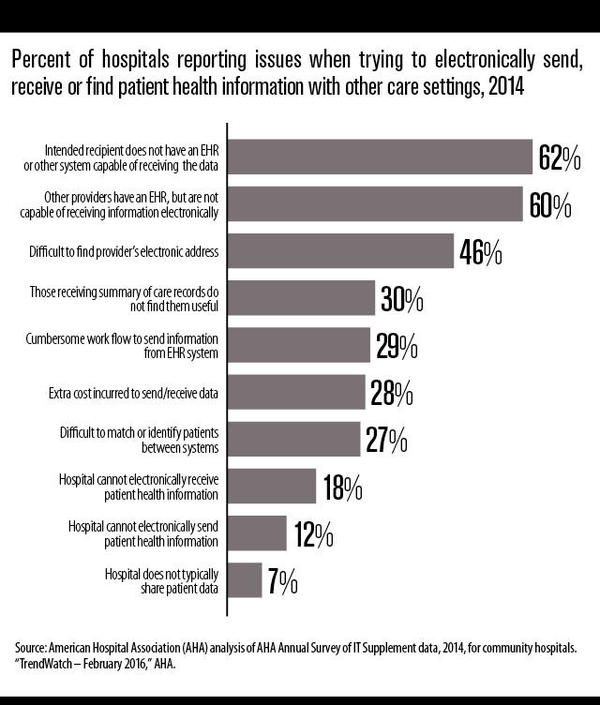Is interoperability in healthcare a dream, or will payers, providers, and technology vendors finally come together to make data more available to one another?
An April 2016 survey by Black Book Market Research found that 83% of physician practices and 40% of hospitals admit that they are still in the planning and catch up stages when it comes to sending and sharing healthcare data.
Patricia B. Wise, RN, MS, MA, FHIMSS, retired Army COL., vice president of the Healthcare Information and Management Systems Society (HIMSS) says interoperability is the "biggest barrier" health systems are facing.
Here are six reasons it is so difficult for healthcare systems to get their information to flow more smoothly.
1. The variety of EHRs and EHR interfaces
Most health systems aren't using electronic health records (EHRs) right out the box. Though EHRs are government certified to meet efficiency standards, they often need hundreds of customizations to make them user-friendly in the workplace. "In hospitals, CIOs are putting these systems in a test environment, and there can be hundreds of unique interfaces," Wise says.
Customizing EHRs through unique interfaces is one of the biggest issues when it comes to interoperability because it increases the complexity required to share information.
Addressing interoperability is also not the only issue healthcare systems face when it comes to EHRs, which means it is not always the top priority. For example implementing and maintaining EHRs can be a strain financially. The Office of the National Coordinator of Health IT (ONC) estimates that the cost of an in-office EHR system at $33,000 and a software as a service (SaaS) system at $26,000. However, maintenance costs can reach $4,000 for in-office systems, and $8,000 for SaaS, annually. Many health IT experts say that this is a conservative estimate when considering new modules and technology, reporting, and support if something goes wrong.
Installing and optimizing an EHR system can also be a tedious process, especially when making that system function properly within a work culture, says Wise.
2. The growing number of data sources
Sixty million fitness, activity, and sport trackers will be sold in 2016. That number could increase to 187 million devices by 2020, according to the CCS Insight's Global Wearables Forecast released in February 2016.
Providers are still wrestling with the relevance of patient-generated health data from wearable health technology and smartphones. But as the market continues to grow, finding ways to store, share, and use data from patients with chronic conditions, elderly patients, wellness programs, and from remote patient monitoring will be a key interoperability issue. Yet, many health systems lack interfaces that can interact with the emerging technology.
Creating fuller health records that can gather this medical information, and also payment and behavioral information, is a future application that requires more layers of interoperability, says Leroy Jones, CEO of GSI Health, a cloud-based healthcare software company. "Other information that is important to the care plan, such as behavioral health and psychosocial information is not the same nature as medical information. Integrating this information into new sources is an emerging challenge," Jones says.
3. New partnerships that increase complexities
As larger hospital systems acquire smaller practices, getting all of the IT systems to work together can be a budget buster, says Beverly Crisler, director of service delivery for Peak 10 Atlanta data centers. "When IT staff is figuring out how to integrate records into a larger system, it can be time consuming. These systems include scheduling, call center management, and possibly paper records. It can be cumbersome, but it's a necessary part of an acquisition that isn't always considered," she says.
Crisler suggests a thorough audit of a potential acquisition's IT system--not just by the CIO, but a taskforce that includes IT staff and system users. "It doesn't need to be intrusive, but you need to know what you are buying before signing the dotted line."
Crisler says an interoperability game plan with a reasonable timetable should be a crucial part of the buying decision. "The CIO can have a business conversation about the areas of concern and ways to respond. The more IT staff is involved in acquisitions, the better for practitioners and patients," Crisler says.
Source: Managed Healthcare (View full article)
Posted by Dan Corcoran on November 29, 2017 07:03 AM




Post a comment